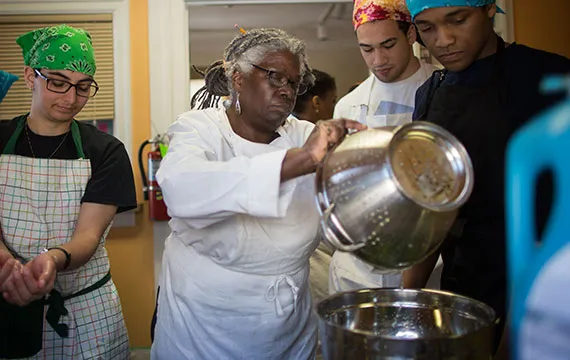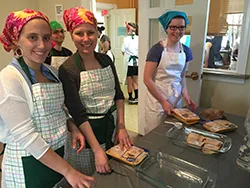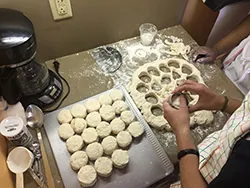A Taste of Culture

Renowned chef Valerie Erwin helps a group of students, staff, and faculty prepare a Low Country feast as part of historian Allison Dorsey's Africa in America: Gullah/Geechee Life and Culture class.
It’s one thing to read about a tradition, notes Indigo Sage ’16, who is studying Gullah Geechee culture this semester. But it’s quite another to get to experience it. And, even better, to taste it.
A group of students, faculty, and staff learned that lesson — and a few others — this week when renowned chef Valerie Erwin came to Swarthmore to help them prepare a Low County feast of chicken and rice, collard greens, and biscuits. A sensory delight that added dimension to studies.
“I really enjoyed being able to connect directly with another person in the now,” says Sage, a sociology & anthropology major from Durham, N.C., “and to have that link not only between printed works and reality, but also between historical events and accounts and participating.”

Community members were expected to "sing for their supper" by helping to prepare the meal and/or clean up afterwards.
“This was a chance to read the food like a text," adds Jamie Thomas, a visiting assistant professor of linguistics who teaches a related course on language and identity in the African experience. "To experience it as a cultural artifact."
Professor of History Allison Dorsey began teaching the course on the Gullah Geechee this year and wanted to take her students to Erwin’s prized Geechee Girl Rice Café in Philadelphia. But it had recently closed, so she invited the chef to campus and gathered funding from the History and Black Studies Departments and the Provost’s Office to help pull off Monday’s event.
This was no free lunch, though — community members were expected to “sing for their supper” by helping to prepare the meal and/or clean up afterwards. About 20 of them stood shoulder to shoulder in the cramped kitchen of the Black Cultural Center, browning the chicken, blanching and sautéing the greens, and baking the biscuits.
“Someone would be at one station, and then they’d tap out and someone else would come in,” says Dorsey. “Everyone got their hands in the mix.”
“There were so many groups of students working on so many things in such a small area that even if I had wanted to micro-manage them, I wouldn’t have been able to,” Erwin says, laughing. “But I have to say, they were really skilled and enthusiastic. I really enjoyed this wonderful collaboration.”
Sage was partially responsible for the biscuits, which she fondly recalls making at home with her mother.
“It was interesting to have an experience that was so familiar, but with different techniques of cooking, a different teacher, and a different community of people,” she says.

"It was interesting to have an experience that was so familiar, but with different techniques of cooking, a different teacher, and a different community of people,” says Indigo Sage '16.
Learning how to cook from others is an emphasis of the Gullah Geechee class, she adds, and not just from recipes. Erwin defied her helpers’ expectations technically, such as using the stems of the greens in the dish and arranging the biscuits in tight rows to prevent them from burning on the sides. But she also defied them thematically, using both a family recipe for the Low Country signature chicken and rice and a cookbook recipe for the more traditionally Southern biscuits.
“My big message was that food is an evolving thing,” she says. “It can reference tradition, but it doesn’t have to stay the same forever.”
Another message subtly imparted onto the group was appreciating the hard work that goes into a meal, which is a tenet of Dorsey’s class on food in the modern era.
“I begin that conversation by hammering that the story of food is the story of labor,” she says. “Without the hands that do the work - the farming, the prep - there is no food.”
The event also reflected the College’s emphasis on fostering community. But for community to be more than just a word, Dorsey says, it “needs to be made and remade every day.”
“You do that by actually living in community,” she says. “It’s about finding opportunities to bring all three layers of the College together in academic and social spaces.”
The event brought even more people together than expected, as students from a class that was being held upstairs came down to plead for a plate. But many hands make light work, and by 5 p.m. the room was “virtually spotless,” says Dorsey.
“With absolutely no leftovers!”



